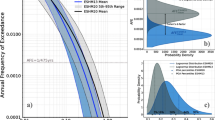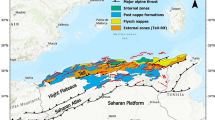Abstract
Based on the moment magnitude scale, a probabilistic model was developed to predict the occurrences of strong earthquakes in the seismoactive area of Zemmouri, Algeria. Firstly, the distributions of earthquake magnitudes M i were described using the distribution function F 0(m), which adjusts the magnitudes considered as independent random variables. Secondly, the obtained result, i.e., the distribution function F 0(m) of the variables M i was used to deduce the distribution functions G(x) and H(y) of the variables Y i = Log M 0,i and Z i = M 0,i , where (Y i ) i and (Z i ) i are independent. Thirdly, some forecast for moments of the future earthquakes in the studied area is given.
Similar content being viewed by others
References
Adamaki, A., E.E. Papadimitriou, G.M. Tsaklidis, and V. Karakostas (2011), Statistical properties of aftershock rate decay: implication for the assess-ment of continuing activity, Acta Geophys. 59,4, 748–769, DOI: 10.2478/s11600-011-0016-2.
Akinci, A. (2010), HAZGRIDX: earthquake forecasting model for ML ≥ 5.0 earthquakes in Italy based on spatially smoothed seismicity, Ann. Geophys. 53,3, 51–61, DOI: 10.4401/ag-4811.
An, W., X. Jin, J. Yang, P. Dong, J. Zhao, and H. Zhang (2007), Application of a time-magnitude prediction model for earthquakes, Appl. Geophys. 4,2, 138–145, DOI: 10.1007/s11770-007-0020-0.
Baddari, K., and A.D. Frolov (2010), Regularities in discrete hierarchy seismoacoustic mode in a geophysical field, Ann. Geophys. 53,5–6, 31–42, DOI: 10.4401/ag.4725.
Baddari, K., G.A. Sobolev, A.D. Frolov, and A.V. Ponomarev (1999), An integrated study of physical precursors of failure in relation to earthquake prediction using large scale rock blocks, Ann. Geophys. 42,5, 771–787.
Baddari, K., A.D. Frolov, V. Tourtchine, and F. Rahmoune (2011), An integrated study of the dynamics of electromagnetic and acoustic regimes during failure of complex macrosystems using rock blocks, Rock Mech. Rock Eng. 44,3, 269–280, DOI: 10.1007/s00603-010-0130-5.
Bogdanov, V.V., A.V. Pavlov, and A.L. Polyukhova (2010), A probabilistic model of seismicity: Kamchatka earthquakes, J. Volcanol. Seismol. 4,6, 412–422, DOI: 10.1134/S0742046310060059.
Catalli, F., M. Cocco, R. Console, and L. Chiaraluce (2008), Modelling seismicity rate changes during the 1997 Umbria-Marche sequence (central Italy) through a rate- and state-dependent model, J. Geophys. Res. 113, B11301, DOI: 10.1029/2007JB005356.
Console, R., D. Pantosti, and G. D’Addezio (2002), Probabilistic approach to earthquake prediction, Ann. Geophys. 45,6, 723–731.
Console, R., M. Murru, F. Catalli, and G. Falcone (2007), Real time forecasts through an earthquake clustering model constrained by the rate- and-state constitutive law: Comparison with a purely stochastic ETAS model, Seismol. Res. Lett. 78,1, 49–56, DOI: 10.1785/gssrl.78.1.49.
Cornell, C.A. (1968), Engineering seismic risk analysis, Bull. Seismol. Soc. Am. 58,5, 1583–1606.
Csikor, F.F., C. Motz, D. Weygand, M. Zaiser, and S. Zapperi (2007), Dislocation avalanches, strain bursts, and the problem of plastic forming at the micrometer scale, Science 318,5848, 251–254, DOI: 10.1126/science. 1143719.
Dahmen, K.A., Y. Ben-Zion, and J.T. Uhl (2009), Micromechanical model for deformation in solids with universal predictions for stress-strain curves and slip avalanches, Phys. Rev. Lett. 102,17, 175501, DOI: 10.1103/PhysRevLett.102.175501.
Das, R., H.R. Wason, and M.L. Sharma (2011), Global regression relations for conversion of surface wave and body wave magnitudes to moment magnitude, Nat. Hazards 59,2, 801–810, DOI: 10.1007/s11069-011-9796-6.
Evison, F. (1999), On the existence of earthquake precursors, Ann. Geophys. 42,5, 763–770.
Gardner, J.K., and L. Knopoff (1974), Is the sequence of earthquakes in southern California, with aftershocks removed, Poissonian? Bull. Seismol. Soc. Am. 64,5, 1363–1367.
Gusev, A.A. (1991), Intermagnitude relationship and asperity statistics, Pure Appl. Geophys. 136,4, 515–527, DOI: 10.1007/BF00878585.
Hanks, T.C., and H. Kanamori (1979), A moment magnitude scale, J. Geophys. Res. 84,B5, 2348–2350, DOI: 10.1029/JB084iB05p02348.
Hu, Y. (1990), Synthetical probability method in analysis of seismic dangerous degree [M], Seismological Press, Beijing, 1–8 (in Chinese).
Kagan, Y.Y. (2002), Seismic moment distribution revised: I. Statistical results, Geophys. J. Int. 148,3, 520–541, DOI: 10.1046/j.1365-246x.2002.01594.x.
Kagan, Y.Y. (2005), Earthquake slip distribution: A statistical model, J. Geophys. Res. 110,5, B05S11, 1–15, DOI: 10.1029/2004JB003280.
Kagan, Y.Y. (2010), Earthquake size distribution: Power-law with exponent β ≡ 1/2?, Tectonophysics 490, 1–2, 103–114, DOI: 10.1016/j.tecto.2010.04.034.
Kagan, Y.Y., and L. Knopoff (1981), Stochastic synthesis of earthquake catalogs, J. Geophys. Res. 86,B4, 2853–2862, DOI: 10.1029/JB086iB04p02853.
Kagan, Y.Y., and F. Schoenberg (2001), Estimation of the upper cutoff parameter for the tapered Pareto distribution, J. Appl. Probab. 38A, 158–175, DOI: 10.1239/jap/1085496599.
Kanamori, H. (1977), The energy release in great earthquakes, J. Geophys. Res. 82,20, 2981–2987, DOI: 10.1029/JB082i020p02981.
Kanamori, H. (2004), The diversity of the physics of earthquakes, Proc. Japan Acad. B 80,7, 297–316, DOI: 10.2183/pjab.80.297.
King, G.C.P., and M. Cocco (2001), Fault interaction by elastic stress changes: New clues from earthquake sequences, Adv. Geophys. 44, 1–38, DOI: 10.1016/S0065-2687(00)80006-0.
Kolmogorov, A.N. (1974), Basic Concepts of Probability Theory, Nauka, Moscow, 200 pp. (in Russian).
Kuksenko, V.S., Kh.F. Makhmudov, and B.Ts. Manzhikov (2010), Damage accumulation model for solids and the catastrophy prediction for large-scale objects, J. Mining Sci. 46,4, 384–393, DOI: 10.1007/s10913-010-0048-z.
Lavenda, B.H., and E. Cipollone (2000), Extreme value statistics and thermodynamics of earthquakes: aftershock sequences, Ann. Geofis. 43,5, 967–982, DOI: 10.4401/ag-3673.
Mezcua, J., J. Rueda, and R.M. García Blanco (2011), A new probabilistic seismic hazard study of Spain, Nat. Hazards 59, 2, DOI: 10.1007/s11069-011-9819-3.
Mouayn, I., B.A. Tadili, L. Aït Brahim, M. Ramdani, M. Limouri, and N. Jabour (2004), Duration magnitude scale and site residuals for Northern Morocco, Pure Appl. Geophys. 161,5–6, 1061–1080, DOI: 10.1007/s00024-003-2497-7.
Ogata, Y., and K. Katsura (2006), Immediate and updated forecasting of aftershock hazard, Geophys. Res. Lett. 33, L10305, DOI: 101029/2006GL025888.
Ogata, Y., K. Katsura, and M. Tanemura (2003), Modelling heterogeneous spacetime occurrences of earthquakes and its residual analysis, J. Roy. Stat. Soc. C — Appl. Statist. 52,4, 499–509, DOI: 10.1111/1467-9876.00420.
Papazachos, B.C., E.E. Papadimitriou, G.F. Karakaisis, and D.G. Panagiotopoulos (1997), Long-term earthquake prediction in the circum-Pacific convergent belt, Pure Appl. Geophys. 149,1, 173–217, DOI: 10.1007/BF00945167.
Pei, T., C.-H. Zhou, Q.-L. Li, and J.-B. Chen (2002), Statistical analysis on temporal-spatial correlativity within temporal doublets of strong earthquakes in North China and its vicinity, Acta Seismol. Sinica 15,1, 56–62, DOI: 10.1007/s11589-002-0047-5.
Pisarenko, V.F., and M.V. Rodkin (2009), The instability of the Mmax parameter and an alternative to its using, Izv. Phys. Solid Earth 45,12, 1081–1092, DOI: 10.1134/S1069351309120052.
Purcaru, G., and H. Berckhemer (1978), A magnitude scale for very large earthquakes, Tectonophysics 49,3–4, 189–198, DOI: 10.1016/0040-1951(78)90177-4.
Serpelloni, E., G. Vannucci, S. Pondrelli, A. Argnani, G. Casula, M. Anzidei, P. Baldi, and P. Gasperini (2007), Kinematics of the Western Africa-Eurasia plate boundary from focal mechanisms and GPS data, Geophys. J. Int. 169,3, 1180–1200, DOI: 10.1111/j.1365-246X.2007.03367.x.
Smirnov, V.B., A.V. Ponomarev, P. Bernard, and A.V. Patonin (2010), Regularities in transient modes in the seismic process according to the laboratory and natural modeling, Izv. Phys. Solid Earth 46,2, 104–135, DOI: 10.1134/S1069351310020023.
Sobolev, G.A. (2011), Seismicity dynamics and earthquake predictability, Nat. Hazards Earth Syst. Sci. 11, 445–458, DOI: 10.5194/nhess-11-445-2011.
Sobolev, G.A., and A.V. Ponomarev (2003), Earthquake Physics and Precursors, Nauka, Moscow, 270 pp. (in Russian).
Steacy, S., S.S. Nalbant, J. McCloskey, C. Nostro, O. Scotti, and D. Baumont (2005), Onto what planes should Coulomb stress perturbations be resolved?, J. Geophys. Res. 110, B05S15, DOI: 10.1029/2004JB003356.
Sykes, L.R. (1983), Predicting great earthquakes. In: H. Kanamori, and E. Boschi (eds.), Earthquakes: Observation, Theory, and Interpretation, North-Holland Publ., Amsterdam, 398–435.
Thatcher, W., and T.C. Hanks (1973), Source parameters of southern Clifornia earthquakes, J. Geophys. Res. 78,35, 8547–8576, DOI: 10.1029/JB078i035p08547.
Utsu, T. (2002), Relationships between magnitude scales. In: W.H.K. Lee, H. Kanamori, P.C. Jennings, and C. Kisslinger (eds.), International Handbook of Earthquake and Engineering Seismology, Vol. 81, Part A, Ser. “International Geophysics”, Academic Press, Amsterdam, 733–746, DOI: 10.1016/S0074-6142(02)80247-9.
Wyss, M., and Y. Toya (2000), Is background seismicity produced at a stationary Poissonian rate?, Bull. Seismol. Soc. Am. 90,5, 1174–1187, DOI: 10.1785/011999158.
Zavyalov, A.D. (2006), Intermediate Term Earthquake Prediction, Nauka, Moscow, 254 pp. (in Russian).
Author information
Authors and Affiliations
Corresponding author
Rights and permissions
About this article
Cite this article
Baddari, K., Makdeche, S. & Bellalem, F. Probabilistic model to forecast earthquakes in the Zemmouri (Algeria) seismoactive area on the basis of moment magnitude scale distribution functions. Acta Geophys. 61, 60–83 (2013). https://doi.org/10.2478/s11600-012-0064-2
Received:
Revised:
Accepted:
Published:
Issue Date:
DOI: https://doi.org/10.2478/s11600-012-0064-2




